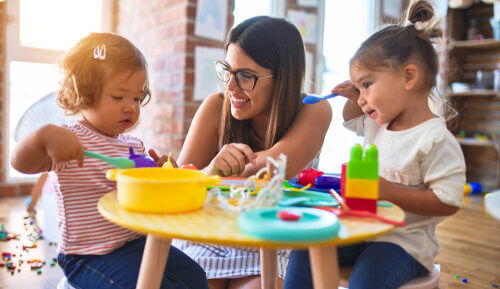
Table of contents
- What is an intergenerational nursery?
- What is an intergenerational activity?
- Advantages of intergenerational nurseries
- How does an intergenerational nursery operate?
- Nursery founder: Intergenerational activities ‘achieving’ early years goals
- History of intergenerational care
- Top tips for intergenerational activities
Table of contents
- What is an intergenerational nursery?
- What is an intergenerational activity?
- Advantages of intergenerational nurseries
- How does an intergenerational nursery operate?
- Nursery founder: Intergenerational activities ‘achieving’ early years goals
- History of intergenerational care
- Top tips for intergenerational activities
What is an intergenerational nursery?
Intergenerational nurseries bring together young children and older adults in intergenerational nursery activities which benefit the different generations and society. Intergenerational care can also take place at a care home, community centre, or even a park. This article highlights the benefits of intergenerational nursery activities to deliver fun, social interactions and shared experiences amongst generations.
What is an intergenerational activity?
Nursery children and older people can share intergenerational activities based on common interests.
This can include arts and crafts, looking at books, listening to stories, singing, dancing, playing games and instruments, exercising, gardening, baking and going for walks.
Bright Horizons Otterbourne Day Nursery and Preschool in Winchester, is located next to a care home. The nursery’s children talk about the care home next door ‘even if a visit wasn’t planned’. The children have made paintings for their older friends in the care home and made 100 cards for the care home residents at Christmas.
Advantages of intergenerational nurseries
When people of different generations spend time together, the impact has many benefits for all ages.
Top benefits of intergenerational nursery for children
Intergenerational nursery activities for young children:
- Improved vocabulary, communication, reading and conversational skills.
- Increased children’s social skills with greater empathy and respect for older people by being around them and learning about them. Children’s understanding of older people increases. Some parents have witnessed their children become gentler with family pets, showing more empathy towards school friends.
- Exposure to diversity creates more inclusive communities in society. Children more likely to talk positively about ageing and old people. This reduces the likelihood of children forming negative stereotypes and prejudices about older people and breaks down barriers between the generations.
- Health and wellbeing benefits include increases in confidence, self-esteem, stress reduction and emotional security. Children gain this from the attention and comforting presence an older person can give. An older person’s calm presence can be a stable influence on children.
- Improves behavioural skills such as patience, as older people do not react or move as fast as children can. Multigenerational influences can support emotional regulation and reduce behavioral problems.
- Fosters a greater understanding of disability. Children learn to work within the boundaries and physical limitations of old people.
- Develops a sense of responsibility in children to be a good companion for an older person.
- Grounds a child’s idea of time and place, as they experience someone with a longer history. By hearing an older person’s stories and experiences, they can learn and understand more about the world, the past, different generations and historical events.
- Models positive behaviours: Older people can provide mentorship and demonstrate patience, kindness, and resilience.
- Learning opportunities. The older generation can teach the young and often help children with tasks such as completing puzzles and learning skills like a musical instrument.
- Fun experiences that benefit all generations, enhancing overall quality of life and wellbeing through activities such as shared games, music, reading, gardening etc.
How does an intergenerational nursery operate?
Judith Ish-Horowicz is the founder and Principal of Apples & Honey Nightingale. This is an intergenerational nursery located within Nightingale House, a Jewish care home in South London.
Apples & Honey is the UK leader in intergenerational care. Set up in 2017, it is the UK’s first intergenerational nursery. It was the first nursery to embed daily intergenerational activities within its early years curriculum. The children of Apples & Honey join elderly residents of Nightingale House taking part in the communal activities.
Here is a video of Apples & Honey Nightingale, which offers intergenerational activities within Nightingale House care home.
Nursery founder: Intergenerational activities ‘achieving’ early years goals
Principal of Apples & Honey Nightingale, Judith Ish-Horowicz said: “The programme has to be developmentally appropriate, we want it to be challenging but we want it also to be accessible to everybody, no matter what their cognitive and physical ability.
“The nursery has exercise classes that work both for people with dementia and those without dementia. We have buddied reading, we do number work together – all this is actually working towards achieving the early learning goals.
“The therapies team measures the impact of our exercise classes on the residents, and the nursery team have watched the children’s communication and language skills and personal, social and emotional development outstrip all expectations.”
Judith added: “I have been visiting Nightingale House, a Jewish care home in South London for nearly 20 years with the children of my nursery, Apples and Honey, and watched the relationships grow and the impact it has had on all involved from children to elderly residents, from the care staff to extended family members.
“It just made so much sense for these interactions to be a daily experience and for there to be a nursery on the site of the home. The children seem to mature more quickly and to be more responsible. They are careful when moving around the residents and are actively concerned for their well-being.
“They benefit from the attention of people who have time to listen to them and to share stories.”
History of intergenerational care
Intergenerational care is thought to have started in 1976, when Shimada Masaharu merged a nursery and a care home in Tokyo. This triggered the opening of more intergenerational care facilities in Japan and the US.
Many children do not have extended family living nearby. Some grandparents live abroad. Geographical distance, deceased grandparents etc, can make it difficult for children to have regular relationships with older people. Children tend to spend less time around their grandparents than in previous generations but such interactions are important.
In the UK, intergenerational care caught the general public’s attention after Channel 4’s TV programme ‘Old People’s Home for Four Year Olds’, (broadcast in 2018), which put 11 older people living in St Monica Trust care home in Bristol with 10 pre-schoolers.
The results were significant improvements in mood, movement and mobility of the older group as well as benefits for children. The first series had such an impact that St Monica Trust in Bristol decided to establish a permanent nursery at a care home.
In Channel 4’s TV programme ‘Old People’s Home for Four Year Olds’, all of the children showed progress in development during the project, according to the early years expert Alistair Bryce-Clegg.
Alistair Bryce-Clegg said: “Residents are the children’s reading buddies, encourage mathematical skills in games sessions and share their life experiences.”
The children were seen to be more confident after spending time with the older people and formed connections with new friends. Now, many nurseries arrange for young children to visit older people in care homes regularly.
Top tips for intergenerational activities
Here are some tips on what parents of nursery children should bear in mind in relation to intergenerational care.
- Encourage children to have fun as it is an opportunity for them to make new friends and create meaningful connections.
- Reiterate and practise good hygiene, such as washing hands and covering mouths when coughing or sneezing, to prevent the spread of illness.
- Teach both the children and older person to respect personal boundaries and to ask for permission before touching or hugging. Children meeting an older person needs to respect the limitations of the older person.
- Ask children to be patient with older adults who may move slower or communicate differently.
- Meeting an elderly person for the first time can be overwhelming. Treat these new relationships carefully and with respect.
- Let children be inquisitive.
- Adapt activities, if required and use common interests. Allow ages to connect and find similarities with each other by making use of objects that can spark interaction e.g. looking through holiday photos.
- Do everyday tasks that make use of common interests e.g. singing can be used as intergenerational activities.
- Try to prepare children for loss and bereavement. Be prepared for older people and young children to form close bonds. Losing someone is part of life experience but it need not be a negative experience. Children can be helped to understand the cycle of life. It is important children are prepared that someone they interact with might not always be around.


